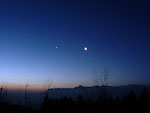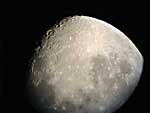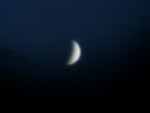 |
A Venus image created by composing 5 shots taken in midday. The camera has a shutter speed up to 1/2000sec., so suitable for bright objects like Venus or Sun.
Taken at Ooizumi vil., Yamanashi pref.
May 18 2001, 10:05 to 10:09 JST(+0900), 1/640 sec. exp., f=12.4mm(with 2-power digital zoom) F3.2
Meade 25cm (10") Schmidt-Cassegrain, afocal method with LV5mm eyepiece
Synthesized focal length:6200mm (equivalent 41300mm in 35mm film format)
CCD sensitivity: ISO80, White Balance: Daylight
5 flames composed, tone level adjusted & unsharp masking processed
|
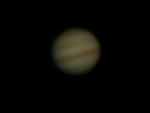 |
A Jupiter image created by composing 7 shots. This image shows a indistinct red spot of Jupiter. Taken at Ooizumi vil., Yamanashi pref.
Oct 27 2001, 24:15 to 24:16 JST(+0900), 1/13 sec. exp., f=46.8mm F3.5
Meade 25cm (10") Schmidt-Cassegrain, afocal method with LV25mm eyepiece
Synthesized focal length:4680mm (equivalent 31174mm in 35mm film format)
CCD sensitivity: ISO160, White Balance: Daylight
7 flames composed, tone level adjusted & unsharp masking processed
|
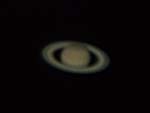 |
This is a Saturn image created by composing 7 shots. The Cassini's division in ring can be recognized somehow. Taken at Ooizumi vil., Yamanashi pref.
Jan 12 2003, 22:31 JST(+0900), 1/4 sec. exp., f=48mm F3.5
Meade 25cm (10") Schmidt-Cassegrain, afocal method with LV12mm eyepiece
Synthesized focal length:9776mm (equivalent 64521mm in 35mm film format)
CCD sensitivity: ISO320, White Balance: Daylight
7 flames composed, tone level adjusted & unsharp masking processed |
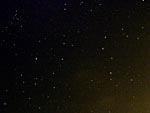 |
A whole image of the constellation of Leo taken with wide ranged side.
This camera has a convenient function of noise reduction algorism in case of long time exposures.
Taken at Ooizumi vil., Yamanashi pref.
Apr 27 2001, 23:04 to 23:09 JST(+0900), 60 sec. exp., f=6.2mm F3.2
CCD sensitivity: ISO320, White Balance: Daylight
2x2 binned 5 flames composed, tone level adjusted & star-sharp filter
|
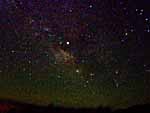 |
This is a wide field image around Scorpius & Sagittarius taken with the interval exposure mode.
The image has been created by composing 8 shots captured automatically with an interval time of 1 minute.
This unique function is very useful because I don't have to be near the camera during photography.
But environmental temperature was high (about 8 degC), this result shows you considerably noisy.
I'll retest in hard winter. Taken at Koumi town, Nagano pref.
May 18 2001, 24:01 to 24:23 JST(+0900), 60 sec. exp., f=6.2mm F3.2
CCD sensitivity: ISO320, White Balance: Fluorescence
2x2 binned 8 flames composed, tone level adjusted & star-sharp filter
|
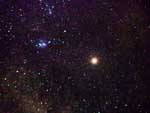 |
This image shows you a field of M8 & closing Mars taken with a focal length of 320mm converted into 35mm film format.
I have taken 8 flames by using of interval exposure mode same as an upper picture. Taken at Koumi town, Nagano pref.
May 18 2001, 25:07 to 25:28 JST(+0900), 60 sec. exp., f=48mm F3.5
CCD sensitivity: ISO320, White Balance: Fluorescence
2x2 binned 8 flames composed, tone level adjusted & star-sharp filter
|
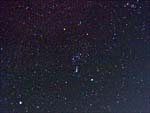 |
A star field around Orion taken under very cold condition(about -8 degC). Low temperature permits me to get fairly good astro-images with low noise.
Taken at Ooizumi vil., Yamanashi pref.
Dec 14 2002, 24:27 to 24:39 JST(+0900), 50sec. exp., f=6.2mm F3.2
CCD sensitivity: ISO320, White Balance: Daylight
2x2 binned 5 flames composed, tone level adjusted
|
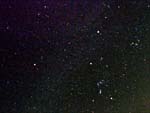 |
This image has been taken with a wide-conversion adaptor, equivalent f=28mm in film format.
It was very cold winter night, you can detect a very dimmed winter's Milky Way in this image due to low noise in CCD chip. Taken at Ooizumi vil., Yamanashi pref.
Dec 14 2002, 26:22 to 26:49 JST(+0900), 60sec. exp., f=6.2mm F3.2, with wide-conversion lens
CCD sensitivity: ISO320, White Balance: Daylight
2x2 binned 10 flames composed, tone level adjusted
|
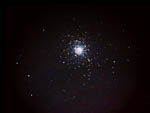 |
A noticeable globular cluster of M5 taken by afocal method method.
The globular clusters are easy to capturing with compact digital still cameras.
It might be needed more composing shots to get sufficient quality equivalent to normal film image. Taken at Ooizumi vil., Yamanashi pref.
May 13 2001, 25:18 to 25:56 JST(+0900), 60 sec. exp., f=6.2mm F3.2
Meade 25cm (10") Schmidt-Cassegrain, afocal method with LV25mm eyepiece
Synthesized focal length:620mm (equivalent 4130mm in 35mm film format)
CCD sensitivity: ISO160, White Balance: Daylight & Fluorescence
2x2 binned 6 flames composed, tone level adjusted & star-sharp filter
|
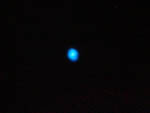 |
This image shows you a compact planetary nebula of "Cat's eye Nebula" in Doraco.
Digital cameras can take better shots of bright planetary nebulae than those taken with SLR camera & films.
A telescope with an aperture of 25cm (10 inch) should resolve detailed structure of this nebula,
but unfortunately this shot could not because of bad seeing condition. Taken at Ooizumi vil., Yamanashi pref.
May 13 2001, 24:07 to 24:22 JST(+0900), 50 sec. exp., f=19.1mm F3.2
Meade 25cm (10") Schmidt-Cassegrain, afocal method with LV25mm eyepiece
Synthesized focal length:1910mm (equivalent 12720mm in 35mm film format)
CCD sensitivity: ISO80, White Balance: Daylight
2x2 binned 5 flames composed, tone level adjusted & star-sharp filter
|
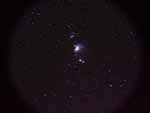 |
This is a wide field image around the Orion Nebula (M42) taken by the afocal method with a telephoto lens for SLR camera and an eyepiece. And this image has been created by composing 5 individual shots.
This facile star-field photographing system can be used for rather large objects. Taken at Ooizumi vil., Yamanashi pref.
Nov 24 2001, 23:46 to 23:58 JST(+0900), 60sec. exp., f=6.2mm F3.2
Tokina AT-X828 zoom f=200mm F2.8, afocal method with LV25mm eyepiece
Synthesized focal length:50mm (equivalent 330mm in 35mm film format)
CCD sensitivity: ISO320, White Balance: Daylight
2x2 binned 5 flames composed, tone level adjusted & star-sharp filter |
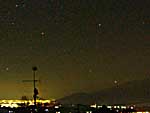 |
A GIF animation image of the diurnal motion of Canopus for about 100 minutes.
A bright star moving near the mountain ridge is Canopus, alpha Carinae. It's rather greenish image because of light pollution. Taken at Ooizumi vil., Yamanashi pref.
(Caution: file size is about 530KB)
Dec 23 2001, 22:56 to 24:41 JST(+0900), 50 sec. exp., f=6.2mm F3.2
GIF animation format from 29 individual shots
CCD sensitivity: ISO320, White Balance: Daylight
|
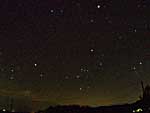 |
This image shows you the Orion and winter constellations sinking in western sky, created from 33 shots taken for 4 hours.
I used a wide-conversion lens and this image area is equivalent to about f=28mm in 35mm film format. Taken at Ooizumi vil., Yamanashi pref.
(Caution: file size is about 1040KB)
Dec 23 2001, 25:47 to 28:53 JST(+0900), 50 sec. exp., f=6.2mm F3.2
With wide-conversion lens
GIF animation format from 33 individual shots
CCD sensitivity: ISO320, White Balance: Daylight |

